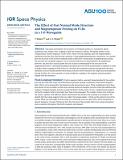The effect of fast normal mode structure and magnetopause forcing on FLRs in a 3‐D waveguide
Abstract
This paper investigates the excitation of waveguide modes in a nonuniform dipole equilibrium and, further, their coupling to field line resonances (FLRs). Waveguide modes are fast compressional ultralow frequency (ULF) waves, whose structure depends upon the magnetospheric equilibrium and the solar wind driving conditions. Using magnetohydrodynamic simulations, we consider how the structure of the excited waveguide mode is affected by various forms of magnetopause driving. We find that the waveguide supports a set of normal modes that are determined by the equilibrium. However, the particular normal modes that are excited are determined by the structure of the magnetopause driver. A full understanding of the spatial structure of the normal modes is required in order to predict where coupling to FLRs will occur. We show that symmetric pressure driving about the noon meridian can excite normal modes which remain around to drive resonances for longer than antisymmetric driving. Further, the critical quantity in terms of efficient coupling is the magnetic pressure gradient aligned with the resonance.
Citation
Elsden , T & Wright , A N 2019 , ' The effect of fast normal mode structure and magnetopause forcing on FLRs in a 3‐D waveguide ' , Journal of Geophysical Research: Space Physics , vol. 124 , no. 1 , pp. 178-196 . https://doi.org/10.1029/2018JA026222
Publication
Journal of Geophysical Research: Space Physics
Status
Peer reviewed
ISSN
2169-9380Type
Journal article
Description
T. Elsden and A. N. Wright were funded by the Leverhulme Trust through Research grant RPG-2016-071. A. N. Wright was also funded by STFC through Consolidated grant ST/N000609/1.Collections
Items in the St Andrews Research Repository are protected by copyright, with all rights reserved, unless otherwise indicated.

